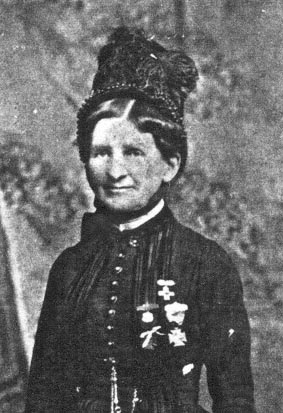Waitie E. Gosper was born October 20, 1830 in New York State. In 1850 she married William Graham, who died twelve years later.
The following year in 1863 she enlisted in the army as a nurse. She was through the siege of the Army of the Potomac. The experiences of the army life always remained dear to her. It was a great delight to her on several occasions to recount her experiences of those days at Grand Army Encampments.
In 1886 she married John J. Gosper of Geneva, Illinois. Four years later they removed to Lincoln Nebraska. During more than forty years she was a public spirited citizen, taking special pride in the growth of the city and the knowledge that she had a part in that growth.
She was an active member of the Womens Relief Corps and prominent in the work of St. Paul's Methodist Church of which she was a member in its early days.
During the years in Lincoln, Mrs. Gosper found time for here one favorite pursuit, that of helping the poor. Until her closing years she was ever on the alert for the poor and needy. She never gathered her information second hand but would go in person to the county commissioners for her list. Many times she did neglect social and business obligations for a visit with some family of the poor. She gave much to charity.
In the early 1870s when Lincoln boasted a population of 2,000 people, Mrs. Gosper established a millinery shop that grew as the city grew for twenty-five years. She was also a builder of Lincoln, having built no fewer than five houses. In every instance she gave her own supervision to the work. She was a woman of dominant will and energy.
She passed away at age 84 on February 1, 1914. A son Frank Graham and a niece Mrs. Bell of Lincoln, and a brother Henry Polley of California survived her. She is buried in Wyuka Cemetery in Lincoln with other Civil War nurses.
When North Platte Tent #23 organized in 1929, they chose the name Waittie E. Gosper.
- Most of this information is taken, almost word for word, from the DUV Department History written 1978 by Cleo Schmidt, Department Bicentennial Chairman.
Juliet Robbins Howe (1825-1904).
Army Nurse, Eastern Theater. Known as "Mother Robbins" to troops.
She may have been the only woman member of Nebraska GAR.
She was a charter member and the first president of Robert Anderson Auxiliary WRC #5, York, Nebraska in 1883, and was also president in 1885, 1886, and 1889.
The old DV Tent #2 of York, which was mustered June 18, 1898, was named Juliet Howe after her. Incidentally, she was not the same person as Juliet Ward Howe (1819-1910) who wrote the Battle Hymn of the Republic.
She is buried in York, Nebraska
 Dr. Hettie Kersey Painter (1820-1889).
Dr. Hettie Kersey Painter (1820-1889).
Dr. Hettie K. Painter, who directed the work of the Army Corps Nurses during the Civil War, had graduated from Penn Medical College in 1860. She was a niece of John Brown.
When the Civil War began she organized the first hospital south of the Potomac under the direction of General Phil Kearny. After the Battle of Bull Run, she followed the New Jersey volunteers into the field where she ministered to their medical needs.
Dr. Painter's son was a telegrapher of the encampment at Hatcher's Run. When she visited him Christmas Day in 1864 at a Negro cabin where he had his instruments set up, he had just relayed a telegram from Maj. Gen. W. T. Sherman to President Lincoln in Washington DC.
She was a petite, calm-faced Quaker woman with a kind smile and the confident inspiring manner of a true physician. She was prominent in temperance, sufferage and other reform movements.
When the war ended she practiced medicine in Washington DC, Alexandria, VA, Salt Lake City, UT, and finally in Lincoln, NE, where her husband had come to work as editor of a semi-monthly farm journal, the "Nebraska Patron."
She opened an infirmary at what is now 15th & U Streets, where she practiced "the application of electricity for acute and chronic cases." Historical documents identify the infirmary as "the first institution of its kind in the West" and she had patients from as far away as Connecticut and California.
Her obituary August 9, 1889 said "the old soldiers have lost a true friend, one ever ready to do good for the veterans in times of peace as she did a quarter of a century ago amid the clash of arms." She is buried in Wyuka cemetery in Lincoln with other Civil War nurses.
The first Nebraska Tent, DV #1 in Kearney in 1890, was named H. K. Painter. DUV Tent #27, organized 1936 in Columbus, also chose the name Hettie K. Painter.
- Most this information is taken, almost word for word, from the Department History written 1978 by Cleo Schmidt.
Home | Civil War nurses | more biographies